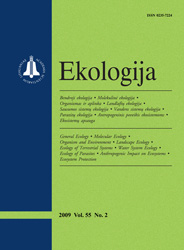 ISSN 0235-7224 ISSN 2029-0586 (online) |
2008 m. Nr. 4 Springtime soil surface respiration and soil vapour flux in different long-term agro-ecosystems
Soil respiration rates vary significantly among major plant biomes, suggesting that vegetation type influences the rate of soil respiration. However, correlations among climatic factors, vegetation distributions, and soil respiration rates make cause–effect arguments difficult. Vegetation may affect soil respiration by influencing soil microclimate and structure, the quantity of residues supplied to the soil, the quality of these residues, and the overall rate of root respiration. Our overall objectives were to evaluate the influence of long-term soil management practices (conventional versus organic farming) on soil surface (0–5 cm) respiration, soil water exchange rate, and CO2 exchange rate during spring season in the stands of winter wheat, spring barley and red clover ley. Investigations of soil and air temperature, air relative humidity influence on CO2 exchange rate were also of great interest. The scientific inquiry was done in fields with different management history. The experimental design involved sites with long-term conventional (CF) and organic (OF) management: 1) winter wheat stand (OF), 2) red clover ley (OF), 3) spring barley stand (OF), 4) winter wheat stand (CF), 5) red clover ley (CF), 6) spring barley stand (CF) and 7) bare fallow (F). Conventional soil management had been used for many decades, while organic management continued for 8 successive years till now. Soil surface water exchange rate, soil respiration and CO2 exchange rate in organically managed fields was significantly higher compared to that in conventionally managed fields. Mean soil surface water exchange rate in winter wheat stands was 0.22, in the soil of red clover ley 0.20, in spring barley stand 0.16, and in bare fallow 0.15 m mol s–1 m–2. Mean soil respiration value during the spring period in winter wheat stands was 6.96, in red clover ley 5.74, in spring barley stand 3.95, and in bare fallow 0.93 μmol s–1. The mean soil CO2 exchange rate value during the spring period in winter wheat stands was 0.71, in red clover ley 1.14, in spring barley stand 0.40, and in bare fallow only 0.11 μmol s–1 m–2. Intensive periodical bare fallow cultivation had a negative effect on soil surface water vapour fluctuation and moisture conservation and suggested the need of plant cover in agricultural lands through all seasons. Practical bare fallow management causes a sharp soil life activity reduction. This measure could be considered as partial soil sterilisation. The more organic matter is added to the soil (OF) the greater vital functions of the soil and the more CO2 is released. Keywords: soil respiration, CO2 exchange rate, soil H2O exchange rate, agro-ecosystems |
Issues:
2011 - Vol.57 No. 1, No. 2 2010 - Vol.56 No. 1-2, No. 3-4 2009 - Vol.55 No. 1, No. 2, No. 3-4 2008 - Vol.54 No. 1, No. 2, No. 3, No. 4 2007 - Vol.53 No. 1, No. 2, No. 2.priedas, No. 3, No. 4 2006 No. 1, No. 2, No. 3, No. 4 2005 No. 1, No. 2, No. 3, No. 4 2004 No. 1, No. 2, No. 3, No. 4 2003 No. 1, No. 2, No. 3, No. 4 2002 No. 1, No. 2, No. 3, No. 4 2001 No. 1, No. 2, No. 3, No. 4 |